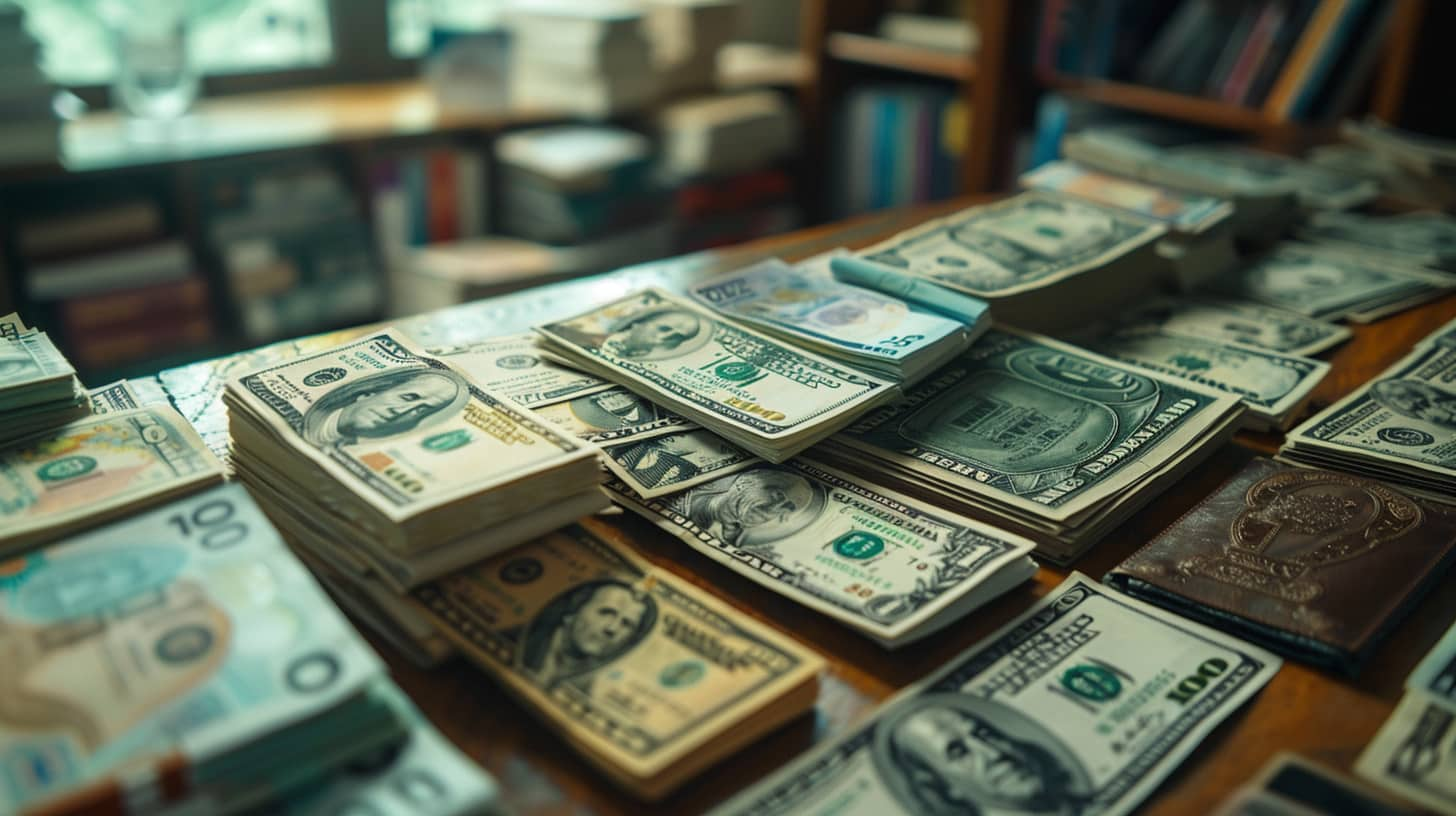When was the last time you handled your financial transactions in a secure and straightforward manner?
While many modern payment options exist, sometimes a good old-fashioned method can come in handy.
As you enter the Post Office to obtain a money order, you might wonder about the various benefits and intricacies involved in this process.
Let’s explore how this traditional yet reliable method can still play a vital role in today’s fast-paced world.
Understanding Money Orders
If you need a secure form of payment that acts like a check, money orders are a reliable option available for purchase at post offices. Money orders are prepaid certificates that guarantee funds, making them ideal for secure mail payments. Unlike personal checks, money orders don’t bounce, providing a secure way to make payments.
At the post office, you can purchase money orders using cash, debit cards, or traveler’s checks. This flexibility allows individuals without bank accounts to still make secure payments when needed. Whether you’re sending money to someone or making a payment that requires guaranteed funds, a money order obtained from the post office is a trustworthy choice.
Understanding the benefits and simplicity of using money orders can provide peace of mind when making payments. Next, let’s explore the advantages of using money orders in more detail.
Benefits of Using Money Orders
When using money orders, you benefit from a secure payment method that’s widely accepted. It provides peace of mind knowing your payment won’t bounce like a check, making it a reliable option for sending funds.
Plus, money orders can be cashed at various locations, offering convenience and accessibility.
Secure Payment Method
Money orders provide a reliable and secure payment method with enhanced security features. They act like checks but offer increased security, making them ideal for sending money through the mail without the risk of bouncing like personal checks.
With money orders, upfront payment is required, ensuring reliability, especially for individuals without a bank account. USPS money orders are cost-effective, priced between $1.45 to $1.95 for domestic transactions. Additionally, international money orders can be sent to 26 countries, each with specific limits on the amount per order.
This makes money orders a secure option for both domestic and international transactions, offering peace of mind when sending funds.
Widely Accepted Option
Considering the secure payment method money orders offer, it’s evident that they are widely accepted by various entities for their reliability and ease of use. Money orders provide a secure way to make financial transactions without the need for a bank account or the risks associated with cash.
They are a convenient option for individuals looking to track their payments and maintain a record of their financial activities. The Post Office makes purchasing money orders easy, offering a reliable service for those seeking a trusted payment method. Below is a table highlighting the benefits of using money orders:
| Benefits | Description |
|---|---|
| Secure Payment | Ensures safe transactions without revealing personal bank information |
| Tracking | Easily monitor and verify payments for peace of mind |
| Convenience | Available at Post Offices nationwide for quick and accessible purchases |
| Widely Accepted | Trusted by businesses, landlords, and individuals for various transactions |
How to Purchase a Money Order
When purchasing a money order at the Post Office, start by selecting the amount you need.
Then, pay the required fee using cash, debit card, or traveler’s checks.
Selecting Money Order Amount
To purchase a money order at the Post Office, decide on the amount you need, keeping in mind the maximum limit of $1,000 and the corresponding issuing fees. Money orders can be issued for amounts up to $1,000, with fees ranging from $2.10 for amounts up to $500 to $3.00 for amounts between $500.01 and $1,000.
If you require a Postal Military Money Order, the fee is lower at $0.70. When selecting the amount for your money order, consider the fees associated with the specific range.
Paying for Money Order
When purchasing a money order at the Post Office, you can pay using cash, a debit card, or a traveler’s check. The issuing fees vary based on the purchase amount, ranging from $2.10 to $3.00. However, Postal Military Money Orders have a lower fee of $0.70. Make sure to have the necessary funds plus the fee amount when you visit the Post Office to buy a money order.
The accepted payment methods provide flexibility for your convenience. Remember to fill out the money order form at the counter during the purchase process. By choosing the appropriate payment method and understanding the fee structure, you can smoothly obtain the money order you need.
Obtaining Money Order Receipt
Consider asking the postal clerk for a money order receipt when purchasing a money order at any Post Office location. The receipt serves as proof of your payment and can be essential for tracking the money order if needed.
It includes details such as the money order number, the recipient’s name, the amount paid, and your signature. Retain the receipt in a secure place until the money order is cashed to ensure you have a record of the transaction.
If any issues arise, having the receipt will help facilitate the process of resolving them. The receipt complements the money order by providing an additional layer of security and documentation for your financial transactions.
Money Order Fees and Limits
Money order fees at the post office vary based on the amount being sent, with costs ranging from $2.10 for amounts up to $500 to $3.00 for amounts between $500.01 and $1,000.
Here are some key points regarding money order fees and limits:
- Postal Military Money Orders: These have a lower fee of $0.70, making them a cost-effective option for individuals sending funds through this service.
- Maximum Amount: The maximum amount for a USPS money order is $1,000, ensuring that larger sums can be securely transmitted using this method.
- International Money Orders: For international transactions, fees differ based on the destination country, offering flexibility for sending money abroad.
- Security and Reliability: Money orders provide a secure and reliable way to transfer funds within the specified dollar limits, giving peace of mind to both the sender and the recipient.
Cashing a Money Order
To cash a money order, visit a post office, bank, or select stores where this service is available. When cashing a money order at the Post Office, you typically won’t need a signature. However, specific requirements may vary depending on where you’re cashing the money order. Remember, rural carriers may also be able to cash money orders if they have enough funds on hand. Here is a table summarizing some key information about cashing money orders:
| Location | Signature Required | Forms of Payment Accepted |
|---|---|---|
| Post Office | Not typically | Cash or Debit |
| Banks | Yes | Cash or Credit |
| Stores | Varies | Cash or Debit |
| USPS | Not typically | Cash or Debit |
Make sure to have the necessary identification and the correct amount when you go to cash your money order. If you encounter a suspicious money order, contact the U.S. Postal Inspection Service for guidance.
Handling Lost or Stolen Money Orders
When dealing with lost or stolen money orders, prompt action is crucial to ensure a swift resolution. Here are the steps to handle a lost or stolen money order:
- Report the Loss: Notify the Post Office immediately if your money order is lost or stolen. You can’t stop the money order, but you can request a replacement.
- Replacement Process: Replacement of a lost or stolen money order may take up to 30 days. You’ll need to fill out a form and pay an $18.00 fee for the replacement.
- Investigation Period: An investigation into lost or stolen money orders can take up to 60 days to complete. During this time, the Post Office will look into the matter and verify the details.
- Refund Request: To request a refund for a lost or stolen money order, visit the Post Office with the money order receipt. They’ll assist you in initiating the refund process promptly.
Frequently Asked Questions
How Do I Ask for a Money Order From the Post Office?
To ask for a money order at the post office, specify the amount needed, pay the fee, and fill out the form. You can use cash, debit card, or a traveler’s check for payment. Postal Military Money Orders have a lower $0.70 fee.
How Long Does It Take to Receive a Postal Money Order?
It usually takes a few days for you to receive a postal money order after purchasing it. Factors like weekends and holidays can affect delivery times. Once you get it, the recipient can cash it like a check.
Is a Postal Money Order the Same as a Money Order?
A postal money order is a type of money order issued by the USPS. It offers a secure way to send money domestically and internationally. You can purchase postal money orders at any USPS location, making them convenient for customers.
Where Is the Easiest Place to Get a Money Order?
The easiest place to get a money order is at your local Post Office. They offer money orders up to $1,000 and accept cash, debit cards, or traveler’s checks. Fees range from $2.10 to $3.00.
Conclusion
So next time you need to send money securely and conveniently, head to your local Post Office to get a money order.
It’s a simple process that offers peace of mind knowing your payment is safe and reliable.
With easy access, affordable fees, and worldwide acceptance, using a money order is a smart choice for your financial transactions.
Don’t hesitate to take advantage of this reliable payment method for all your money-sending needs.
Related Resources
USAA Money Order Mastery: Streamlining Financial Transactions



